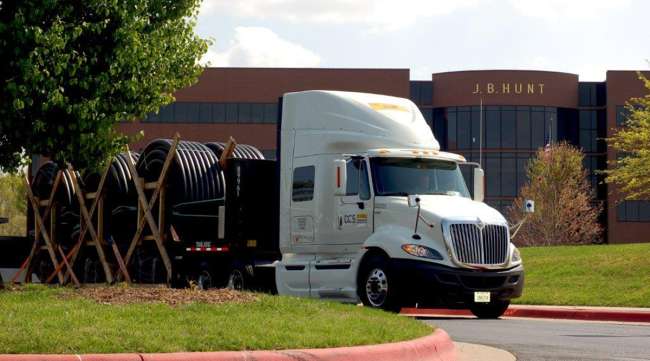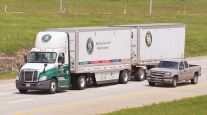J.B. Hunt Profits Grow Significantly Due to the Tax Cuts and Jobs Act

J.B. Hunt Transport Services Inc. announced that profits more than tripled in the fourth quarter, although, as will be the case across multiple industries, the results were bolstered by a significant tax credit related to the Tax Cuts and Jobs Act signed last month.
Investors and analysts will have to dig deeper into the financial statements to assess core business conditions before benefiting from a corporate tax rate cut to 21%.
For J.B. Hunt, profits were $385.3 million, or $3.48 per share, including a $245.5 million tax benefit. One year ago, the truckload carrier earned $117.6 million or $1.05. In total, J.B. Hunt estimated it will pay $309.2 million less in taxes in a “reasonable estimate of the change in future tax rates on deferred tax balances at December 31, 2017, as a result of the Tax Cuts and Jobs Act enacted in the quarter.”
Earnings before taxes, a metric that would exclude the new corporate tax rate, were down 26% to $139.8 million.
If one applied the old 37.6% effective tax rate, then J.B. Hunt’s profits would’ve been $87.2 million, or about 78 cents. At the end of December, J.B. Hunt executives announced that investors should expect lower than anticipated earnings, giving a range of between $85 million and $90 million, or about 70 cents to 82 cents per share.
Operating income decreased to $145.8 million from $194.4 million for the fourth quarter of 2016.
On the other hand, revenue grew 16% to nearly $2 billion, about $80 million better than the Bloomberg News consensus forecast of industry analysts.
For the entire year, revenue grew 10% to $7.2 billion while earnings, before changes in the tax code, slipped 14% to $595.2 million.
In the J.B. Hunt Intermodal unit, the largest in the company, revenue grew 10% to $1.1 billion, but operating income fell 25% to $93.3 million. Volumes grew 5% year-over-year to 515,669, including 7% growth in the eastern United States and a 4% increase in transcontinental. Revenue per load grew 5% to $2,129.
“Benefits from increased volume and revenue per load were offset by increased costs to attract and retain drivers, higher third-party dray costs, increased insurance and claims costs and inefficiencies in the rail networks due to congestion and track and yard maintenance,” the company wrote in a statement.
In J.B. Hunt’s Dedicated Contract Services, revenue was up 20% to $477 million, but operating income plunged 39% to $34.9 million. Volume increased 13% to 686,475 and revenue per truck per week grew 4% to $4,426, even though the average length of haul went down 3 miles to 178 miles. Part of the growth was tied to an additional 1,326 trucks compared with a year ago.
“Approximately 53% of these additions represent private fleet conversions versus traditional dedicated capacity fleets and primarily reflect new contract implementations in this and prior periods. Customer retention rates remain above 98%,” the company said. “The increase in revenue and improved asset utilization was offset with higher driver wages, including the timing between wage increases and recovery through customer contracts and higher driver recruiting costs, including the length of time to fill open positions.”
J.B. Hunt’s Integrated Capacity Solutions, the third-party logistics and freight brokerage division, generated the most positive results. Revenue jumped 40% to $323 million and operating income surged 86% to $11.3 million. The company credited the results to adjusting its mix of business to handle more spot business rather than locked-in contract loads, since purchased transportation costs are setting new records.
Loads in the division climbed 17% to 277,911 and revenue per load rose to $1,163 from $974 one year ago.
“Gross profit margin increased to 14.1% in the current period from 12.9% last year primarily from the increased spot market activity which more than offset the margin compression realized in the contractual volumes,” the company wrote.
Margins were slightly lower due to higher technology spending on the JBHunt360 app. The company also sent out an e-mail to carriers that it would cease posting loads on the DAT and Internet Truckstop and shuttle all traffic to the JBHunt360 load board, although it remains to be seen whether it’ll follow though with the measure.
In the J.B. Hunt Truck unit, the smallest division, revenue was up 1% to $97 million, but operating income slipped 5% to $6.4 million. Revenue, excluding fuel surcharge, was essentially flat, even through revenue per load grew 13% because load counts dropped 10% to 87,538.
“Favorable changes from higher revenue per load were offset by higher driver wages and independent contractor costs per mile, lower tractor utilization from an increase in unseated trucks and higher insurance and claims costs,” the company wrote.
J.B. Hunt ranks No. 4 on the Transport Topics Top 100 list of the largest for-hire carriers in North America.




